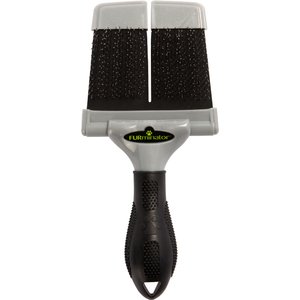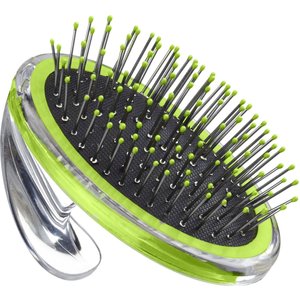
 Best Overall Dog Brush
Best Overall Dog Brush































































What is a Dog Brush?
Dogs need consistent grooming, and a dog brush makes it easy to keep their coats healthy and clean. These tools remove mats, tangles, loose fur, and dirt without damaging your dog's skin. Additionally, brushing your dog regularly helps with deshedding and removing any uncomfortable, matted tufts of fur. Some brushes are designed with deshedding in mind, while others massage simultaneously, making the brushing process more enjoyable for the dog.
Choosing the Right Dog Brushes
Picking out the correct dog brushes to use on your canine companion can seem baffling. The correct brush can have a big impact on the health, condition, and comfort of your dog’s skin and coat, especially if you have a long-coated or double-coated dog whose coat is prone to matting.
Whatever type of coat your dog has, brushing helps remove dirt and dead hair, serves as a time to bond with your pup, and gives you the opportunity to notice anything unusual -- such as cuts or sore spots. Remember to brush the undercoat, as well as the top coat, if your dog is double-coated. If you have a puppy, start brushing right away to get him used to being handled, and use a soft brush on that fluffy puppy coat, so he’ll learn to enjoy it.
Whether you're new to dog grooming or have simply never gotten a handle on which brushes are best to use, keep reading and we'll teach you how to choose the right dog brushes.
Types of Dog Brushes
You may find the large number of available dog brushes to be a barrier when trying to figure out which to use. We've listed the most common types and what they're used for. Choose based on the size of your dog, his breed, and coat type.
Slicker Brushes
Slicker brushes consist of brush heads covered with short, tightly-packed wire pins angled to go through the coat and avoid the skin. Use them on medium-coated, long-coated, wire-coated, and curly-coated dogs to remove mats and prevent mats from forming by removing loose hair. Maintain a light touch when using slicker brushes, as pressing down hard could cause discomfort.
Bristle Brushes
Bristle brushes have a large number of natural or synthetic bristles. They're best used on short-coated dogs, including dogs with short silky coats, to remove loose hair and dander and stimulate the skin. You can use them on double-coated breeds as a finishing brush to smooth the coat and add shine.
Pinhead Brushes
Pinhead brushes look a lot like human hairbrushes, with medium-spaced wire pins all over the brush head, often with rubber tips to prevent scratching the skin. Although commonly used, these aren't the most versatile of brushes. They're best used as finishing brushes for long-coated breeds to smooth the hair and remove dirt, and to work through tangles on wire-coated dogs. You can often find double-sided dog brushes that combine pinhead brushes with bristle brushes.
Undercoat Rakes
Undercoat rakes have one or two rows of metal pins designed to penetrate through to the undercoat to remove loose fur, and remove and prevent mats. You can use undercoat rakes on double-coated breeds of all fur lengths. However, you must choose the correct pin length for your dog's coat length. Wide-toothed combs can also help remove mats and tangles.
Rubber Brushes
Rubber brushes have short, flexible rubber bristles. They're mostly suited to use on short-coated dogs, since the bristles won't penetrate through long or thick coats. They massage the skin and bring dirt and loose hair to the surface, where you can remove it with a bristle brush. A soft, rubber grooming mitt that fits on your hand will also remove dead hair and dirt from your dog’s coat.
Other Factors to Consider
Once you've decided which brushes you'll need to groom your dog, there are more factors to consider.
Brush size: You can't expect to use the same size brush on a Chihuahua and a Saint Bernard. Choose an appropriate brush size for the size of your dog.
Ergonomic grip: You'll thank yourself for buying dog brushes with comfortable, ergonomic handles after a long grooming session -- especially if you have multiple dogs or long-coated dogs that take time to groom.
Self-cleaning function: Some types of brushes, particularly slicker brushes, have a self-cleaning function. This consists of pins that retract at the press of a button, so you can easily remove hair and dirt.
Wet/dry use: You can use most rubber brushes wet, as well as dry, making them ideal for massaging shampoo into dogs' coats when bathing them or brushing out dead hair and tangles when they’re slippery from shampoo.
There are two main types of dog brushes: pin brushes and bristle brushes. The former features long, thin stainless steel pins and are ideal for dogs with long-haired dogs, while the latter has pins with soft caps on them and work better with short-, medium-, and some long-haired breeds.
Most dog brushes are designed to not irritate dogs' skin. However, if you apply too much pressure or yank too hard while attempting to get out a knot, it could be painful for your dog. Remember to be gentle and to cut out mats if they are too thick to brush out.
Slicker brushes have fine, short wires close together. They're ideal for removing mats, but they can also be used to brush away loose fur.















